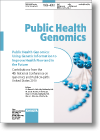Ushering Public Health Practice into the 21st Century
Posted on byThe April 2012 special issue of the journal Public Health Genomics includes 13 articles from the many presentations at the 4th National Conference on Genomics and Public Health in the United States: “Using Genetic Information to Improve Health Now and In the Future”. The three-day conference sponsored by the Centers for Disease Control and Prevention, the National Institutes of Health and other cosponsors was held December 2010 in Bethesda, Maryland, and attended by more than 700 participants. The conference brought together clinical and public health scientists and practitioners. The published articles showcase current work and consider future directions for applications of genomics to improve health, including behavioral interventions to prevent and control diseases, genetic services across the lifespan; family history tools for primary care; training and education of the public health workforce, and addressing health disparities through a genomics lens. The conference articles highlight the need for a strong scientific evidence base for applying genomics to improve health and prevent disease, consider gaps in the current health care delivery system, and address the schism between traditional public health departments and clinical care. The articles also discuss the implications of “genohype” and internet availability of genomic information on the development of new communication strategies for public health practice.
In the article I coauthored with Ron Zimmern, chairman of the UK PHG Foundation and pioneer in the young field of public health genomics, we highlight six issues that currently contribute to the large divide between genomic sciences and traditional public health practice.
- Genes or environments? There is a need to integrate new biological knowledge into public health programs that address social and environmental issues rather than perpetuate a false dichotomy between social and biological models of health and disease.
- Genetic exceptionalism: There is a need to move beyond the notion that genetic information requires more regulation and scrutiny than other medical or health information.
- Public access to genomic information: Public health will have a bigger role as an “honest broker” delivering credible and actionable information as millions of people will be searching for information, including genomic information, to improve their health.
- Personal autonomy: Genomic information will increase the need by public health practitioners to consider personal autonomy as they provide information to improve health.
- Individuals vs. populations: Public health practice will need to be refined to include the provision of unbiased information that supports individual choice and decision making, as compared to current practice which tends to target health improvement at the population level through policy changes and guiding individual choice with incentives and disincentives.
- One size does not fit all: Increasingly, our public health interventions will be stratified to subsets of the population based on genomic information, as genomics helps to illustrate ways that individual differences in response to social and environmental factors contribute to variation at the population level.
New insights from genomic science will have practical implications for the organization of health services, the deployment of bioinformatics and new information systems, the need for evidence-based processes and the role of the private sector in different countries. The 4th national conference papers exemplify the controversies we face, the promising opportunities to consider, the potential for intervention innovations, and the public health research questions that need to be answered to move the field forward.
This special issue of public health genomics is published coincidentally with an Institute of Medicine report: “For the public’s health: investing in a healthier future”. The report makes a series of recommendations to strengthen the role of public health practice in helping communities assess and take action on the multiple factors that shape their health; to support clinical care delivery system in improving population health; and to inform policies that affect the fundamentals of health in the United States. As we travel into the 21st century, the issue is not if but when emerging genomic information will be applied to pressing public health problems. This is indeed an exciting time for the young field of public health genomics.
Posted on by



